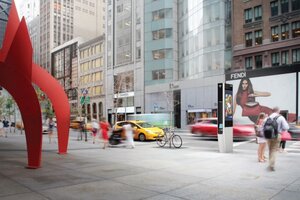New York City’s first free phone-booths-turned-Wi-Fi hubs go live
LinkNYC, a free public gigabit Wi-Fi network in New York City, turned on access at its first four hubs in Manhattan this week. When it's completed, LinkNYC will offer free Internet access across all five boroughs of New York.

A press image shows a LinkNYC Wi-Fi hotspot in Midtown Manhattan.
LinkNYC
In 2014, New York City officials unveiled LinkNYC, an ambitious plan to remove the city’s 6,400 pay phones and replace them with 10-foot-tall Wi-Fi hubs offering free Internet across the five boroughs. This week, the first four hubs went live, allowing New Yorkers on Third Avenue between 15th Street and 19th Street to connect to the network.
LinkNYC is still in beta testing, but the group administering the network, a consortium of companies including Qualcomm and Intersection, plans to cover almost the entire city by 2025.
Most municipal Wi-Fi projects only offer coverage in city centers, and often only for a few hours a day. LinkNYC, by contrast, will offer a connection 24/7 and will also allow New Yorkers to place free calls to any phone in the US.
The four current hubs offer download and upload speeds greater than 300 Mbps, reports tech site The Verge, which is about 25 times faster than the average US Internet connection. Each LinkNYC hub is connected to the network by a newly laid fiber optic cable.
When it’s done, the LinkNYC network will comprise up to 10,000 hubs, delivering super fast Internet to New Yorkers. City officials have argued that Internet access is an important resource for bringing economic opportunities to New York and allowing people to lift themselves out of poverty. New York Mayor Bill de Blasio wrote in an op-ed in The Huffington Post last February that “the Internet has become fundamental to solving” income inequality, and that affordable broadband Internet is “an essential building block of economic opportunity.”
Officials have said that Internet speeds won’t be slower in poorer neighborhoods, where advertisers may be less interested in purchasing space on the sides of the Wi-Fi hubs.
LinkNYC uses a login system to keep users connected across the entire network. Creating an account requires an e-mail address, which officials say won’t be shared with advertisers or anyone else. The network itself uses encryption to keep the data being transmitted to and from users secure.
Each LinkNYC hub will offer Wi-Fi coverage for at least 150 feet in all directions, according to the companies that designed the network. That means more or less seamless coverage, particularly in Manhattan, which will have the highest hub density once the network is completed. It also means, however, that the LinkNYC network won’t reach more than a few stories above ground level – so New Yorkers living in tall apartment buildings probably won’t be able to cancel their home Internet subscription.
Still, if the roll-out continues smoothly the network could be a model for other cities, offering connectivity to any resident or visitor who wants it.
[Editor's note: This story has been changed from its original version to more accurately describe the organizations behind LinkNYC. The effort is led by a consortium of companies including Qualcomm and Intersection.]

